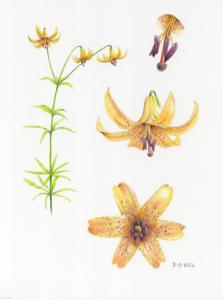Sale on canvas prints! Use code ABCXYZ at checkout for a special discount!

NEWSLETTER July/August 2011
Greetings from the mountains of western Maine!
On the downhill side of summer now, you’re getting a combined July/August newsletter this time.
Our star this month is the showiest wildflower we have, the stately Canada Lily, Lilium canadense. With its golden crown of graceful nodding blossoms, it is enough to make me gasp when I come across one unexpectedly. Once it was a common flower from Canada to Alabama in the eastern half of the United States. Now it has become more rare across parts of its range, and is even considered threatened in Indiana, Rhode Island, New York, and Tennessee.
I first found a Canada Lily blooming in our back yard two years ago. Last year we had none; this year we have five! The plants are two to five feet tall, the flowers three or four inches across, with one or more flowers on each plant. The petal color varies from yellow to orange, spotted inside with the color called “Tuscan Red” in my pencil box. The flowers have no fragrance that I can discern. The leaves grow in whorls of three to twelve in each group. I have read that native Americans used this plant medicinally to treat stomach disorders, rheumatism, irregular menstruation, and snake bites.
Canada lilies are perennials. They bloom in mid-July, and the seed pods are formed by mid-August. Once ripe, the seeds need a month or two of warm, moist weather followed by a good long spell of winter weather in order to germinate. It can take them a year or two to produce blooms, but the wait is well worth it. They love the wet soil in old fields near streambeds, moist wood margins, or damp meadows, which is a good description of our backyard.
Like many plants in the lily family, the Canada Lily appears to have 6 petals. But to be botanically accurate, because of the flower’s structure the inner three are considered to be petals, and the outer three are sepals. Collectively they can be called “tepals,” which as far as I can see signifies, “they all look the same to me.”
The drawings were done in colored pencil on Arches hot-pressed (smooth) watercolor paper, from photographs that I took this summer.
Canada Lilies reproduce either by seeds or from offshoots of the corms, the large scaly roots. Only one of the plants in my backyard has produced a good big seed pod. I have marked it, and am watching it as it matures and ripens. When it is fully ripe, dry, and splitting open, I plan to collect the seeds and see if I can start some more Canada Lily plants.
My gift to you this month is this: if you would like to try starting some Canada Lilies, too, send me a reply to this email, along with your street address, and I will send you a few seeds (with planting instructions) when they are ready. I would like to do all I can to keep this graceful beauty in our woods and fields. They like sun or partial shade, and moist soil conditions, if you have a place like that.
For more information on “Swift River Treasures,” my artmaking process, or recent work, or to check out my blog, see my website at http://betsy-bell.artistwebsites.com/. Here you can order prints of my work, and have them matted and framed if you choose, courtesy of Fine Art America’s great print-on-demand service. They also offer greeting cards, either single or in packages.
If you want to look at the Moments of Transcendence book, here is the link to it on the Blurb.com booksite: http://www.blurb.com/bookstore/detail/2034640 . And my online store for shirts, mugs, and housewares with Swift River Treasures art on them can be found at http://www.printfection.com/mainemountainart .
I perhaps owe having become a painter to flowers. (Claude Monet)
Thanks for joining me in the journey. I hope that you enjoy looking at the art as much as I have enjoyed making it! I would love to hear from you, too, so please do reply with comments.
Betsy